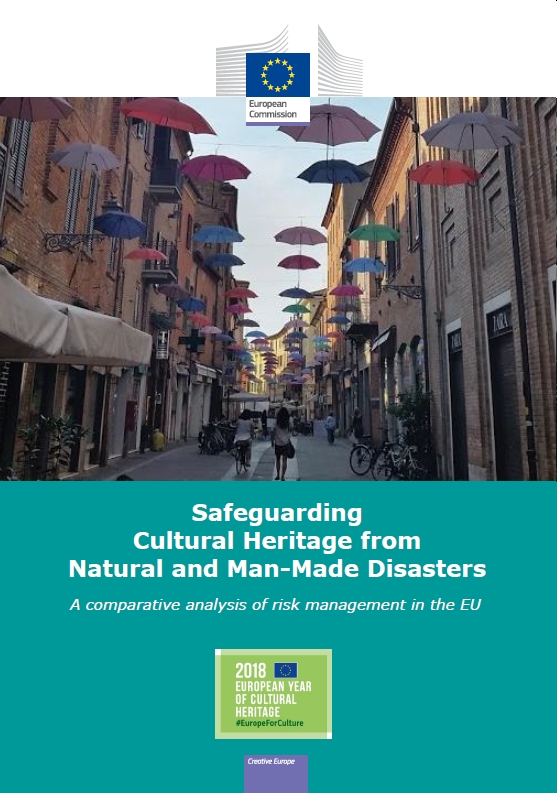Safeguarding Cultural Heritage from Natural and Man-made Disasters: a comparative analysis of risk management in the EU

|
| Safeguarding Cultural Heritage from Natural and Man-made Disasters: a comparative analysis of risk management in the EU, Alessandra Bonazza, Ingval Maxwell, Miloš Drdácký, Ellizabeth Vintzileou, Christian Hanus, European Commission, 2018, 205 pages, e-book available online on open access: https://publications.europa.eu/en/publication-detail/-/publication/8fe9ea60-4cea-11e8-be1d-01aa75ed71a1/language-en |
‘Safeguarding Cultural Heritage’ is a study undertaken on behalf of the cultural policy unit of the European Commission’s directorate-general for education, youth, sport and culture. It attests to the priority that the commission attaches to the safeguarding of cultural heritage as a ‘strategic resource for a sustainable Europe’. It synchronises with the United Nation’s Sendai Framework for Disaster Risk Reduction 2015–2030, the global agreement on disaster risk management. It is an important guide and resource across a field that has gained accelerating recognition and importance since the turn of the millennium.
The study’s objective is to integrate cultural heritage into the national disaster and risk reduction strategies developed by EU member states and contribute to the development of good practice. Three stages were undertaken: first, an informational overview; second, mapping existing strategies in all member states, focusing on existing competence centres and tools; third, the identification of strengths and weaknesses, followed by recommendations for measures to improve risk management at the European level.
The chapter ‘Literature study and existing initiatives at EU and international level’ incorporates themed sections that address climate change, air pollution changes and environmental degradation, flood, landslide, wind, earthquake, volcanic eruption, fire and armed conflict. Each section includes literature reviews and information on training and dissemination actions; several of the references relate to research projects and publications initiated by Historic Environment Scotland. Definitions are incorporated into the study where appropriate.
Key lessons learnt from the study included the general lack of coordination between and across different risk-management strategies, lack of alignment in the responsibility chain from policy making to practical application, and the low current priority of cultural heritage in risk-management planning. The recommendations are framed in line with the Sendai Framework’s four priorities.
- First, understanding disaster risk, raising awareness, and supporting innovative national level programmes.
- Second, strengthening disaster risk governance and collaboration for preparedness, emergency reaction and recovery, and supporting the use of IT tools to facilitate operational procedures.
- Third, investing in disaster risk reduction for resilience through the establishment of priorities for the protection and rescue of cultural heritage assets.
- Fourth, enhancing disaster preparedness for effective response and to build back better in recovery, rehabilitation and reconstruction, including developing early warning and damage modelling systems, and the drafting of European Standards for safeguarding specific categories of cultural heritage assets against the effects of different types of disaster.
The study identified numerous and consistently repeated gaps in preparedness. It divided these omissions into the following: understanding allied to policy making measures and strategies; coordinated administrative and managerial implementation supported by public awareness and the monitoring of vulnerabilities; and practical application underpinned by comprehensive inventories of assets at risk, prioritising multi-risk complex-system scenarios in urban historic centres, archaeological sites and cultural landscapes, notably from the impacts of climate change, and the need for support in the development of effective early warning systems.
‘Safeguarding Cultural Heritage’ is an important open access resource for all who are engaged in the vital field of cultural heritage disaster risk management.
This article originally appeared as ‘Better watch out’ in Context 168, published by the Institute of Historic Building Conservation (IHBC) in June 2021. It was written by Dennis Rodwell, architect-planner, consultant in cultural heritage and sustainable urban development .
--Institute of Historic Building Conservation
Related articles on Designing Buildings Wiki
- Conservation.
- Cultural heritage.
- Helping communities recover from disasters and protecting them before they occur.
- Heritage asset.
- Historic building.
- How to rebuild using the debris from disasters.
- IHBC articles.
- Managing and responding to disaster.
- Research and development in disaster response.
- Risk management.
- The Institute of Historic Building Conservation.
IHBC NewsBlog
Images from inside a Grade II listed hotel show the scale of its collapse
The Corbett Arms in Tywyn has fallen into serious disrepair.
Old Sarum fire in listed (& disputed) WW1 Hangar - Wiltshire Council has sought legal advice after fire engulfed a listed First World War hangar that was embroiled in a lengthy planning dispute.
UK Antarctic Heritage Trust launches ‘Virtual Visit’ website area
The Trust calls on people to 'Immerse yourself in our heritage – Making Antarctica Accessible'
Southend Council pledge to force Kursaal owners to maintain building
The Council has pledged to use ‘every tool in the toolbox’ if urgent repairs are not carried out.
HE’s Research Magazine publishes a major study of the heritage of England’s suburbs
The article traces the long evolution of an internal programme to research 200 years of suburban growth
IHBC Context 183 Wellbeing and Heritage published
The issue explores issues at the intersection of heritage and wellbeing.
SAVE celebrates 50 years of campaigning 1975-2025
SAVE Britain’s Heritage has announced events across the country to celebrate bringing new life to remarkable buildings.
IHBC Annual School 2025 - Shrewsbury 12-14 June
Themed Heritage in Context – Value: Plan: Change, join in-person or online.
200th Anniversary Celebration of the Modern Railway Planned
The Stockton & Darlington Railway opened on September 27, 1825.
Competence Framework Launched for Sustainability in the Built Environment
The Construction Industry Council (CIC) and the Edge have jointly published the framework.














